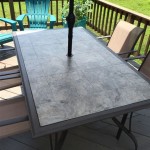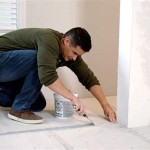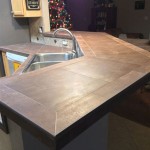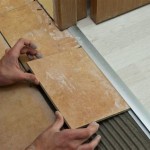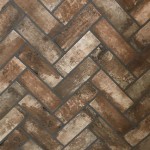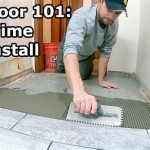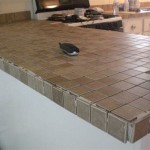Can You Put Luxury Vinyl Plank Over Ceramic Tile? Factors to Consider
Many homeowners considering renovations often explore cost-effective and time-saving options. One common question that arises is whether luxury vinyl plank (LVP) can be installed directly over existing ceramic tile. The answer is generally yes, it is possible. However, the success of this installation hinges on several critical factors that must be carefully evaluated before proceeding. Rushing into the installation without addressing these factors can lead to problems such as uneven surfaces, compromised adhesion, and ultimately, a flooring failure requiring costly repairs.
The appeal of installing LVP over tile is understandable. It avoids the labor-intensive and messy process of removing the existing tile, which can involve demolition, debris removal, and subfloor preparation. Moreover, it can save significant time and money. However, skipping these steps requires meticulous preparation and a thorough understanding of the conditions of both the ceramic tile and the planned LVP.
This article will delve into the key considerations to determine if installing LVP over ceramic tile is a viable option for a specific project. It will cover the necessary preparation steps, potential issues that may arise, and best practices for ensuring a successful and long-lasting installation.
Substrate Condition and Preparation: The Foundation of Success
The single most important factor in determining the feasibility of installing LVP over ceramic tile is the condition of the existing tile floor. The tile surface needs to be structurally sound, level, and clean. Any loose, cracked, or uneven tiles must be addressed before the new flooring is installed. Failure to do so will telegraph these imperfections through the LVP, resulting in an uneven and potentially unstable floor.
Begin by thoroughly inspecting the entire tile floor. Look for any signs of damage, including cracks, chips, and loose tiles. Gently tap each tile with a rubber mallet or similar tool. A hollow sound indicates that the tile is not properly adhered to the subfloor and needs to be re-secured or replaced. Remove any loose or damaged tiles carefully to avoid further damage to the surrounding tiles or the subfloor.
Once damaged tiles are removed, the resulting gaps need to be filled with a cement-based patching compound. This compound should be specifically designed for filling voids in tile floors and should be compatible with both the existing tile and the LVP adhesive. Follow the manufacturer's instructions for mixing and applying the patching compound, ensuring that it is level with the surrounding tiles. Allow the patching compound to fully cure before proceeding.
Leveling the tile floor is another crucial step. Even slight variations in height can create problems with the LVP installation. Use a self-leveling underlayment to address any unevenness. This type of underlayment is a pourable compound that spreads evenly across the floor, creating a smooth and level surface. Again, follow the manufacturer's instructions for mixing and application, paying close attention to the recommended thickness and drying time. A self-leveling underlayment is particularly important if the grout lines are wide or deep, as these can create an uneven surface even if the tiles themselves are level.
Finally, the tile surface needs to be thoroughly cleaned and prepared for the LVP adhesive. Remove any dirt, dust, grease, or other contaminants that could interfere with the adhesion of the LVP. Use a degreasing cleaner and a scrub brush to clean the tile surface, followed by a thorough rinsing with clean water. Allow the floor to dry completely before proceeding to the next step. Some manufacturers recommend lightly sanding the tile surface to create a better bond for the adhesive. Check the LVP manufacturer's recommendations for specific surface preparation requirements.
Grout Lines and Their Impact on LVP Installation
Grout lines present a unique challenge when installing LVP over ceramic tile. The depth and width of the grout lines can create an uneven surface that will telegraph through the LVP, resulting in visible lines and potentially causing the LVP to crack or separate over time. Addressing grout lines properly is essential for a smooth and professional-looking installation.
For narrow grout lines (typically less than 1/8 inch), a thick self-leveling underlayment may be sufficient to fill the lines and create a smooth surface. However, for wider or deeper grout lines, additional steps may be necessary. One option is to fill the grout lines with a cement-based grout filler. This filler should be specifically designed for filling grout lines and should be compatible with both the existing grout and the LVP adhesive. Apply the grout filler according to the manufacturer's instructions, ensuring that it is flush with the surface of the tile.
Another option is to apply a skim coat of cement-based patching compound over the entire tile floor. This will create a completely smooth and level surface, eliminating any potential problems with grout lines. Apply the patching compound according to the manufacturer's instructions, using a trowel to spread it evenly across the floor. Allow the patching compound to fully cure before proceeding to the next step. Sanding the cured patching compound can further smooth the surface and improve the adhesion of the LVP adhesive. Consult the LVP manufacturer's recommendations for specific surface preparation instructions regarding grout lines.
It’s important to consider the type of LVP being used. Thicker LVP options often offer better performance over slightly uneven surfaces due to their increased rigidity. However, even with thicker LVP, proper grout line treatment is crucial for a long-lasting and aesthetically pleasing result. Neglecting this step can lead to premature wear and tear, requiring replacement sooner than expected.
Understanding LVP Thickness, Type, and Adhesive Compatibility
The choice of LVP and the adhesive used are critical considerations when installing over ceramic tile. Not all LVP products are created equal, and selecting the appropriate type and thickness for the specific application is essential for a successful installation.
Thicker LVP options are generally more forgiving of minor imperfections in the substrate. Look for LVP with a thickness of at least 4mm or greater when installing over ceramic tile. Thicker LVP is also more resistant to indentation and wear, making it a good choice for high-traffic areas. The wear layer, which is the top protective layer of the LVP, is another important consideration. A thicker wear layer will provide greater protection against scratches, scuffs, and fading.
There are several types of LVP available, including glue-down, click-lock, and loose-lay options. Glue-down LVP is generally the most stable and durable option, making it a good choice for installations over ceramic tile. However, it requires the use of a specific adhesive that is compatible with both the LVP and the tile surface. Click-lock LVP is easier to install but may not be as stable as glue-down LVP, especially over uneven surfaces. Loose-lay LVP is the easiest to install but is generally not recommended for installations over ceramic tile, as it may be prone to shifting or buckling.
Selecting the right adhesive is crucial for ensuring a strong and long-lasting bond between the LVP and the ceramic tile. Use an adhesive that is specifically designed for installing LVP over non-porous surfaces such as ceramic tile. The adhesive should also be compatible with the specific type of LVP being used. Consult the LVP manufacturer's recommendations for specific adhesive requirements. Always follow the adhesive manufacturer's instructions for application, including the recommended trowel size, open time, and curing time.
Before starting the installation, it is advisable to conduct a test area to ensure that the adhesive is bonding properly and that the LVP is adhering to the surface. Apply the adhesive to a small section of the tile floor and install a few pieces of LVP. Allow the adhesive to cure completely, and then test the bond strength by attempting to lift the LVP. If the LVP is difficult to remove and the adhesive is securely bonded to both the LVP and the tile, then the adhesive is likely compatible and the installation can proceed. If the LVP is easy to remove or the adhesive is not bonding properly, then a different adhesive may be necessary.
In summary, properly preparing the existing ceramic tile floor, addressing grout lines effectively, and selecting the appropriate LVP thickness, type, and adhesive are all critical factors in determining the success of installing LVP over ceramic tile. These steps require careful attention to detail and adherence to manufacturer's recommendations. By addressing these key aspects, homeowners can achieve a beautiful and durable new floor without the expense and hassle of tile removal.

New Vinyl Plank Flooring Over Tile Table And Hearth

New Vinyl Plank Flooring Over Tile Table And Hearth

New Vinyl Plank Flooring Over Tile Table And Hearth

New Vinyl Plank Flooring Over Tile Table And Hearth

Lvt Flooring Over Existing Tile The Easy Way Vinyl Floor Installation Diy

Can You Put Vinyl Plank Flooring Over Ceramic Tile Floors Blvd

Can You Install Vinyl Plank Over Tile Flooring America

New Vinyl Plank Flooring Over Tile Table And Hearth

How To Install Luxury Vinyl Plank Over Tile Flooring

Lvt Flooring Over Existing Tile The Easy Way Vinyl Floor Installation Diy
Related Posts

